What is DALI Lighting Control System?

DALI, short for “Digital Addressable Lighting Interface”, is an intricate digital protocol used for controlling LED luminaire systems. DALI lighting control encapsulates dimming the luminaires, controlling individual LEDs or groups of LEDs, changing colors of the RGBW LEDs, controlling the brightness and warmth of LEDs, and much more.
DALI system communicates between LED ballasts, LED drivers, motion sensors, and brightness sensors. The interoperability introduced by the DALI network opens up vast possibilities for lighting applications.
DALI protocol uses digital signals to transfer lighting commands via a two-way system. A user sends the digital messages to LED drivers and ballasts using computer software. You can also run diagnostics, troubleshoot the lighting system, record and recall up to 16 DALI scenes in a DALI system.
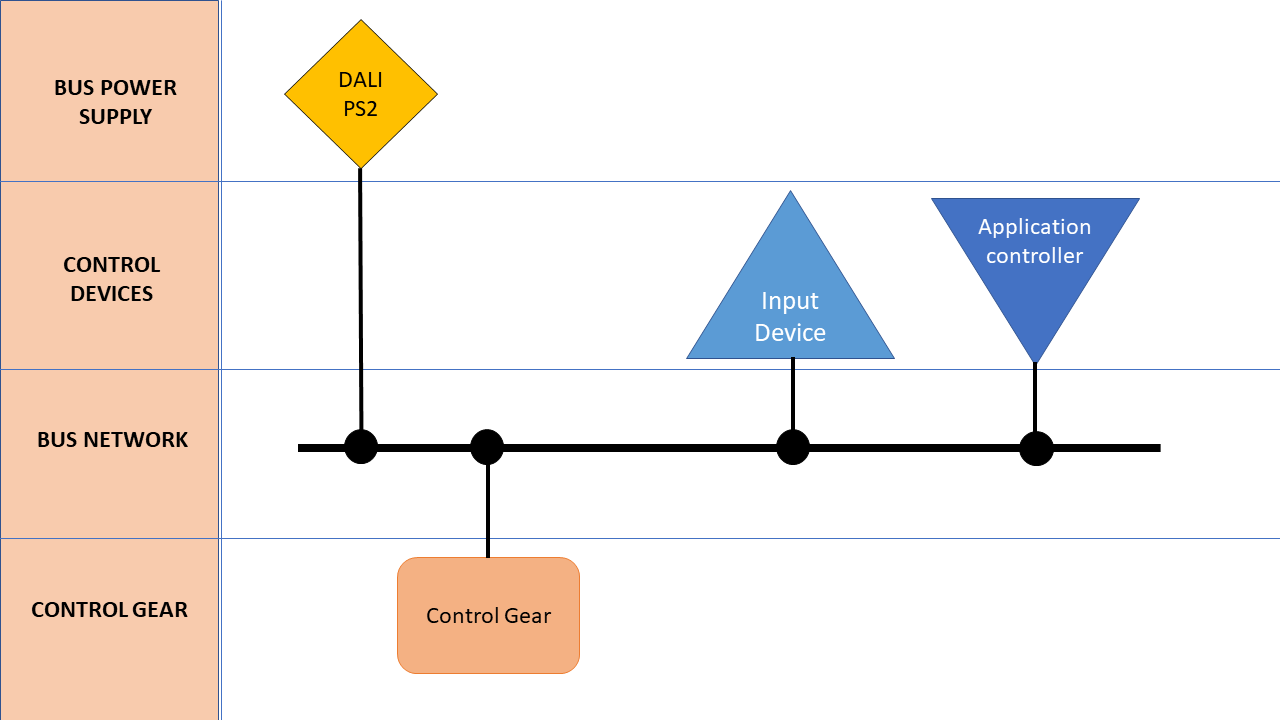
DALI Control– An Open Standard
First introduced way back in the 1990s, the digital addressable lighting interface is an open protocol, which means it is publicly available and compatible with various lighting equipment by different manufacturers.
The components to be used must have a DALI logo that affirms compatibility irrespective of the manufacturing company.
The international standard IEC 62386 defines the technical specifications of a DALI system. Only the components that fulfill “digital illumination interface alliance (DiiA)’s” tests and protocols are allowed to have the DALI trademark.
DALI-1 Vs. DALI-2
DALI 2 is the improved version of the original DALI 1 network. DALI 2 comprises control devices, i.e., application controllers (the “brains” of the system) and input controllers besides control gear. Moreover, DALI 2 interoperability between different manufacturers’ lighting equipment.
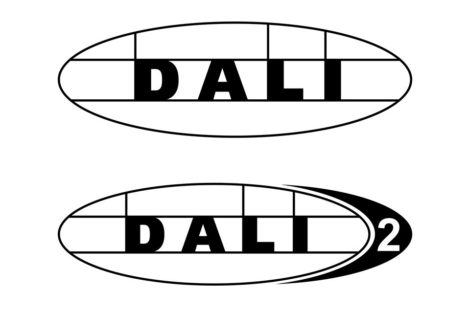
How Does DALI Work?
DALI system works by sending commands through a DALI bus to the unique addresses of LED drivers that control the final light output. The system mainly consists of three components, DALI bus power supply, control input devices, and control gear.
Let’s understand the components involved in a DALI system and how they work in harmony.
DALI Bus
DALI system comprises an unpolarized DALI bus which is the core of the entire network. The two-wire bus carries command signals from the input/application controllers to the receiving devices (LED drivers).
The two-way protocol is not only used for controlling lighting but also helps in:
- Configuring the entire lighting system
- Finding out which luminaire in the building is malfunctioning
- Receiving information about current lighting conditions of all luminaires
A DALI power supply supplies power of 16 V to the bus system.
Control devices
Control devices are categorized into two types; application controller and input device. In addition, control devices can collectively use the functionalities of both components.
Application controllers
An application controller receives information, makes decisions, and sends the final commands to the devices on the receiving end. These controllers can process information from various sources, such as input devices, external bus systems devices, control gear, and other controllers.
These components regulate all the data traffic on the bus system.
Input Devices
Input control devices send real-time, user-generated commands to the lighting system. These simple devices can include:
Light level sensors: Such components sense the light level in any room or space and adjust the colors of the output light to maintain the optimum illumination. Light level sensors work best in cases where the perfect mix of daylight and artificial light is needed.
PIR motion detectors/occupancy sensors: Such a DALI device lights up the lamps/lighting groups by detecting movement.
Pushbuttons/sliders: Used for simple operations such as turning on/off a light or group of lights. This also includes devices like color wheels.
Dimming controller plates: Used for adjusting dimming
Scene controller plates: Used for controlling and adjusting the scenes
Building Management Systems: Helps manage and control the lighting of an entire building
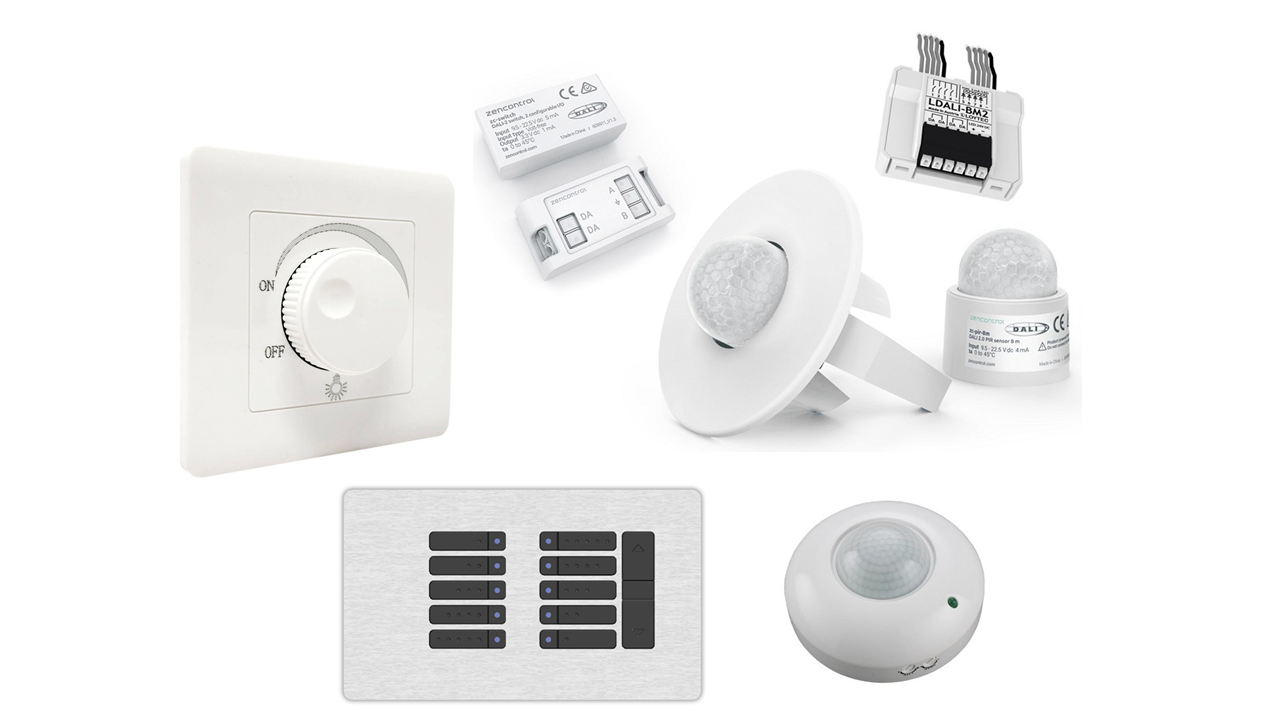
Application controllers attend 24-bit signals from input devices and transfer 16-bit commands to control gear.
The command generated from the control unit goes to the control gear that regulates the current in your LED lighting fixtures. DALI master devices send commands to slave components (i.e., DALI driver).

Control Gear
The receiving end of the system consists of control gear, which is mainly DALI LED drivers that supply light to the lamp(s). DALI LED driver takes commands from the application/input controllers and supplies the required current to the lamp. DALI networks support various LED drivers and ballast systems.
Dali Addresses
Each LED driver is assigned a unique address that is used to control that driver. The addressable features open up a new horizon of controllability. We can group a number of luminaries and send commands to them simultaneously, or we can control individual lights.
Addresses allow flexibility in scene-setting and grouping. We can also assign specific input device controllers, such as sensors and switches, to certain light fixtures according to the applications.
What are the Advantages of Using DALI Systems?
DALI protocols provide a myriad of advantages, and we have listed them below.
- DALI emergency lighting: DALI protocols offer DALI emergency lighting (self-test) that notifies you when any fitting in the system is not working or malfunctioning. This is helpful for the maintenance of extensive projects. Instead of asking the maintenance team to check every room on every floor of the building, the integrated building management system can be connected to DALI and you can identify the emergency in a few seconds.
- The two-way system: Due to the bi-directional property, the signals are sent to and fro, enabling the devices on the network to communicate seamlessly.
- Quick re-configuration: One of the best things about DALI devices is that they can be configured easily and quickly if the system is shifted to another building or space.
- Bus topology: DALI components can be connected in any topology, e.g., star, tree, daisy chain line, etc. (More on this in the section below ‘how can dali be wired?’ )
- Reducing cable lengths: The 16V bus power supply is used to supply power to all the connected compounds, thus reducing the need for individual power supplies. DALI offers flexible topology and is polarity-free, resulting in less cable cost and increased efficiency.
- Scalability: One DALI network is limited to 64 devices. You can assign every device to 16 groups and 16 scenes. For extensive projects, we can control multiple DALI individual networks through overall control systems. Only DALI can offer such extensive control.
- Switching lighting presets: You can feed various lighting presets in the DALI system and switch between them with just a button. For example, you can create custom lighting for parties or meetings and alternate between them whenever you want.
Where Are DALI Lighting Systems Used?
DALI system is used to control lighting in large commercial and residential areas where lighting automation is required. DALI provides the flexibility to control individual as well as grouped lighting systems. All this is done by a central control unit which gives access to all the luminaires of the building at your fingertips.
Many commercial settings prefer this lighting system. With this smart control, the same floor can have multiple lighting systems configured to the requirement of separate offices. Business hubs, commercial offices, and production houses have unique lighting needs.
An efficient control system like DALI can give holistic control and cater to this uniqueness. Its smart two-way communication gives you a bird’s eye view of the lighting system of the building.
These days homeowners are also taking great interest in the excellent controllability of the DALI. The work-from-home culture is prevailing these days, and if anyone wants to convert some space from a bedroom to a home office, they can do just that without additional wiring and hassle. Just select the different configurations for the specific luminaire, and you are good to go.
DALI system can be installed in the existing lighting setup. But it is seen through experience that it works best when there is a brand new installation. That way, you can avoid the previous control circuits and wiring. This gives the user a simpler, efficient, and clean wiring setup.
How Does DALI Compare to 1-10V?
DALI and 0/1-10V drivers are both used for dimming and controlling LED Lights. DALI uses a digital approach, while 1-10 V driver uses an analog system. A comprehensive comparison is given below. Let’s start with understanding the basics.
How do 0-10V and 1-10V driver works?
A typical 0-10 V driver sends an analog DC voltage signal to the LED lamp. The voltage level defines the light output. The brightness diminishes to 0% at zero volts and reaches maximum output, i.e., 100% at 10 volts.
1-10V works similarly to the 0-10V driver, but the minimum voltage reduces to 1 volt only. This results in a minimum of 10% of the original brightness. To go further, you have to switch off the light. This feature gives a smoother dimming transition, giving you greater control over the place’s ambiance.
How does the DALI lighting system work?
“Digital Addressable Lighting Interface-DALI,” a digital dimmer in simpler terms. It communicates with the LED driver digitally, sending signals to execute commands. The DALI controller is operated via software. We have already discussed the detailed working of the DALI lighting control circuits above.
DALI compared to 0-10V and 1-10V
| Lighting Control System Protocols | Nature | Wiring | Direction |
| 0-10 v , 1-10 v dimming driver | Both 0-10 and 1-10V are analog in nature, giving out voltage signals. Use for Dimming feature. | Each LED luminaire needs separate wiring to connect 0/1-10V driver. It gets complicated when large and complex lighting systems are concerned. | These drivers are uni-directional, meaning that only the end-user like you, can send signals to the lamp.No information regarding the performance and output travels back to the source. |
| DALI Lighting system | Digital signals are sent to the LED luminaires ensuring precise control over the brightness. Use for dimming, control, adjusting the color temperature, etc. | DALI system has much simpler wiring. Each LED lamp has a separate address and can be controlled digitally via central command control. Ideal for handling large and complex lighting systems. A single DALI control cable can be connected to 64 LED drivers. It can easily be integrated into the existing lighting system, unlike other lighting protocols. | The DALI system is bi-directional, meaning two-way communication is possible. Issues regarding performance and output can be communicated back to central control and examined via software. |
How does DALI compare to KNX LON and BACnet?
DALI, KNX, LON, and BACnet are several proprietary protocols used for automation. Building automation in any industry has become a top requirement these days.
It helps businesses grow and be efficient. The key to automation is effective communication between electrical devices known as protocols.
Check out this table for easy comparison.
Comparison Table
| Communication Protocols | |
| BACnet | BACnet, short for “Building Automation and Control,” is an open protocol for nearly all the automation requirements. An effective protocol that can computerize any automation device irrespective of its nature. It is a data protocol that works on electrical standard RS-485. Most commonly used in the Heating, Ventilation, and Air conditioning (HVAC) industry. Others include security, safety, and audio application. Build by ASHRAE |
| LonWorks | LonWorks, short for “Local Operating Network,” a protocol for building automation. It also serves as an electric standard for digitized communication, apart from data protocol. Wiring includes a twisted pair of cables and a power line. Former operates on 78 kbit/s and latter at 3.6/5.4 kbits/s.Used in HVAC, Transportation, fire detection, Lighting, etc. Outdated as compared to other protocols.Build by Echelon Corporation |
| KNX | KNX is an open protocol used for automation in commercial and domestic areas. A flexible network that does not have any specific hardware module. It can be controlled via a PC and 8-bit microcontroller. Mostly used in Europe. |
| DALI | DALI, “Digital Addressable Lighting Interface,” is a specialized protocol developed for just lighting applications. DALI can be integrated into the already established BACnet and LonWorks protocols. The specialized design gives an edge to DALI over BACnet, LonWorks, and KNX, at least in lighting applications. Many DALI compliant devices are available in the market, making it a preferred protocol for lighting needs. |
Are all DALI Products Compatible With Each Other?
Short answer, “Yes.” All DALI products offer a high level of compatibility with each other, but there are some exceptions. Exceptions are typically in some features like “Night Light Functions.” The Market has devices labeled “DALI Compatible” and “DALI Compliant.”
Devices labeled as “Compatible” may only have parts DALI systems embedded in them by the lighting equipment manufacturers and are not tested thoroughly over DALI protocols.
The DALI “Compliant” devices come with an official LOGO and have a full range of compatibility over a wide range of operations. These devices are manufactured by “DALI Member Companies” and are always a better option to buy.
How is DALI Wired?
The best thing DALI offers is the flexibility in bus wiring topology. You can arrange devices in bus arrangement, daisy chain, star, tree networks, or any combination of all of them. It does not work with mesh, ring, mixed, or fully connected networks.
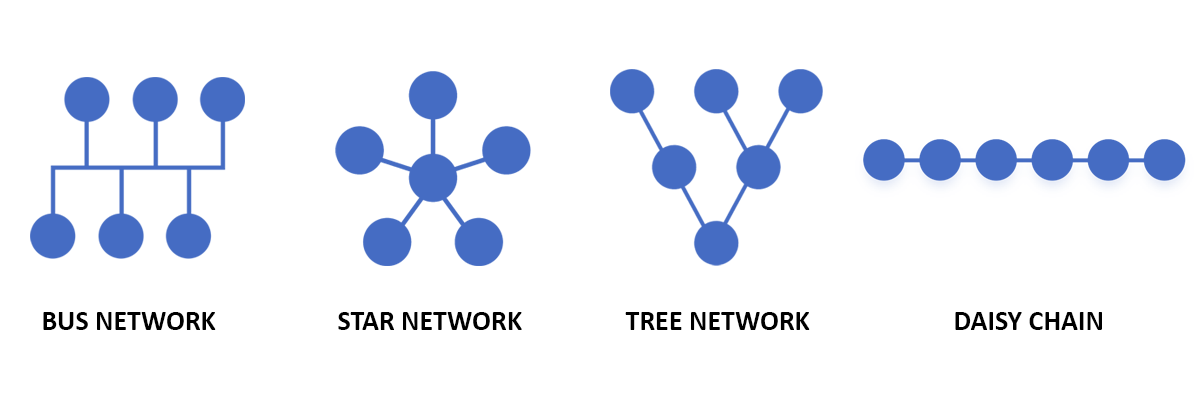
You can insert controllers and sensors anywhere in the arrangement.
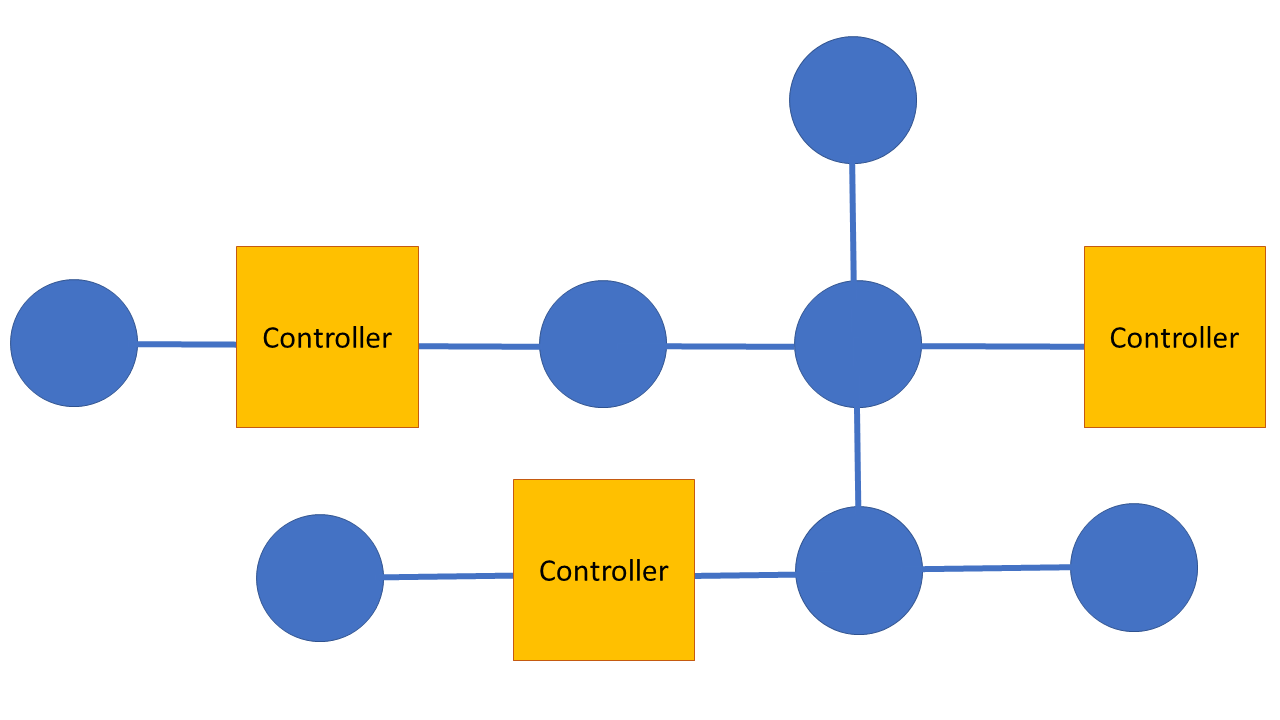
Final Thoughts
In conclusion, DALI offers a big opportunity to increase a building’s lighting efficiency, lighting control, flexibility in operation, ease in installation, interoperability, reduction of light maintenance costs, and making your wireless lighting control dream a reality.
DALI can control RGBW and/or tunable white lamps. You can create and feed multiple scenes in the luminaire’s memory to be used later. It is far better than analogous proprietary protocols, as a digital protocol can achieve a high level of precision and consistency in dimming and color control.
Have further questions regarding DALI? Contact RC Lighting and get all your queries answered today.





